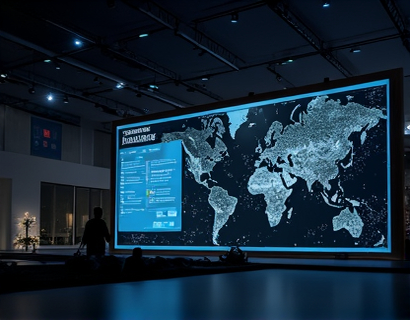Next-Gen QR Code Technology: Revolutionizing Business and Social Media Engagement for Modern Brands
In the rapidly evolving digital landscape, businesses and social media managers are constantly seeking innovative solutions to enhance engagement and streamline interactions with their audience. One such technology that has emerged as a game-changer is next-generation QR code technology. This advanced form of QR codes is not just an improvement over the traditional version but a complete reimagining of how information can be shared, accessed, and interacted with. These next-gen QR codes are customizable, intuitive, and designed to meet the demands of modern brands looking to deepen their digital presence and foster stronger connections with their audience.
The evolution of QR codes from simple black and white squares to sophisticated, multi-functional tools reflects the broader trends in digital technology. Traditional QR codes have been a staple in marketing and information dissemination, providing a quick and easy way to link physical and digital worlds. However, they have limitations in terms of design flexibility, data capacity, and user experience. Next-gen QR codes address these limitations, offering a range of enhancements that make them more versatile and effective in various applications.
Enhanced Customization Options
One of the most significant advantages of next-gen QR codes is their customization capabilities. Unlike traditional QR codes, which are limited to a standard shape and color scheme, next-gen QR codes can be tailored to match a brand's identity. This includes custom shapes, colors, and even logos. Such personalization not only makes the QR codes more visually appealing but also helps in brand recognition and recall. For instance, a retail brand can design QR codes that reflect their unique style and aesthetic, ensuring that every interaction with the code reinforces brand identity.
Moreover, the customization extends to the content linked to the QR code. Brands can direct users to specific landing pages, offer exclusive content, or even create interactive experiences. This level of control allows businesses to craft a more engaging and relevant user experience, which is crucial in a market where consumer attention is fragmented across multiple platforms.
Increased Data Capacity
Another key feature of next-gen QR codes is their enhanced data capacity. Traditional QR codes have a limited amount of data they can store, typically around 2,000 characters. This constraint often necessitates the use of shortened URLs, which can lead to higher bounce rates and a less seamless user experience. Next-gen QR codes, on the other hand, can store significantly more data, sometimes up to several kilobytes. This increased capacity allows brands to include detailed information, such as product descriptions, videos, and even interactive elements, all within a single QR code.
The ability to embed rich media content directly through QR codes transforms them from mere linkers to comprehensive information hubs. For example, a travel company can use a QR code to provide potential customers with a video tour of a destination, along with detailed itineraries and booking links. This not only enhances the user experience but also increases the likelihood of conversion by providing valuable and engaging content upfront.
Improved User Experience
The user experience is a critical factor in the success of any digital tool, and next-gen QR codes are designed with user convenience in mind. The scanning process for next-gen QR codes is faster and more reliable, reducing the frustration that users might experience with traditional QR codes. This is particularly important in scenarios where quick access to information is essential, such as in retail environments or during events.
Additionally, next-gen QR codes often integrate with mobile apps and other digital platforms, creating a seamless transition from the physical to the digital world. For instance, a QR code can be scanned to unlock exclusive content within a brand's mobile app, providing a cohesive and integrated experience. This integration not only enhances user satisfaction but also encourages deeper engagement with the brand's digital offerings.
Boosting Social Media Engagement
Social media platforms are where a significant portion of modern engagement takes place, and next-gen QR codes are finding innovative ways to enhance interactions on these platforms. By placing QR codes in social media posts, businesses can drive traffic to their websites, increase app downloads, or even encourage in-store visits. The visual appeal and interactive nature of these QR codes make them a compelling addition to social media content.
For example, a fashion brand can include a QR code in a Instagram post that, when scanned, takes users to a virtual try-on feature. This not only engages the audience but also provides a unique and memorable experience that can lead to higher conversion rates. Similarly, event organizers can use QR codes to provide attendees with real-time updates, maps, and schedules, enhancing the overall event experience and encouraging sharing and interaction on social media.
Fostering Deeper Connections
The ultimate goal of any engagement strategy is to build meaningful relationships with the audience. Next-gen QR codes facilitate this by providing brands with tools to create personalized and contextually relevant interactions. By linking QR codes to personalized content, such as customer-specific offers or tailored information, brands can foster a sense of connection and loyalty.
For instance, a subscription-based service can use QR codes to offer personalized content based on a user's preferences and past interactions. When a user scans the QR code, they might be directed to a page with recommendations or exclusive offers, making the experience feel more personalized and valued. This level of personalization can significantly enhance customer satisfaction and retention.
Use Cases Across Industries
The versatility of next-gen QR codes makes them applicable across a wide range of industries. Here are a few examples of how different sectors are leveraging this technology:
- Retail: Retailers use QR codes on product packaging to provide detailed product information, customer reviews, and even virtual product demonstrations. This not only enhances the shopping experience but also helps in building trust and credibility.
- Healthcare: Healthcare providers can use QR codes to share patient information securely, streamline appointment scheduling, and provide educational materials. This improves efficiency and patient care.
- Education: Educational institutions can use QR codes to provide students with access to course materials, interactive learning tools, and virtual campus tours. This enhances the learning experience and makes it more accessible.
- Real Estate: Real estate agents can use QR codes to provide virtual property tours, detailed property information, and virtual staging. This allows potential buyers to explore properties remotely, saving time and enhancing the buying process.
These use cases demonstrate the broad applicability of next-gen QR codes and their potential to transform various aspects of business operations and customer interactions.
Challenges and Considerations
While next-gen QR codes offer numerous benefits, there are also challenges and considerations that businesses should be aware of. One key challenge is ensuring compatibility across different devices and scanning apps. To maximize reach and usability, it's essential to test QR codes on a variety of devices and ensure they work seamlessly.
Another consideration is the security of the content linked to the QR codes. Brands must ensure that the information and links are secure and trustworthy to maintain user trust. Implementing HTTPS links and verifying the authenticity of the content can help mitigate security concerns.
Additionally, while customization is a significant advantage, it's important to strike a balance between creativity and functionality. Overly complex designs can sometimes hinder scanning efficiency, so simplicity and clarity should be prioritized where possible.
Conclusion
Next-gen QR code technology represents a significant leap forward in how businesses and brands can engage with their audience in the digital age. With enhanced customization, increased data capacity, improved user experience, and broad applicability across industries, these QR codes offer a powerful tool for modern engagement strategies. By leveraging this technology, brands can create more meaningful, personalized, and interactive experiences that drive deeper connections and higher engagement. As the digital landscape continues to evolve, embracing next-gen QR codes can be a strategic move for any brand looking to stay ahead of the curve.










































